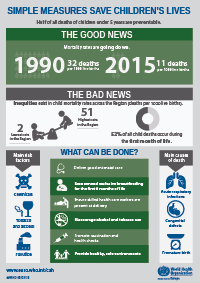Data and statistics

Health information
Information is an essential and expensive resource. Focused systems are necessary to gather the right data and turn them into relevant and timely information. The traditional collection of routine statistics needs regular review in order to ensure relevance to modern needs. Accurate information from a core set of indicators disaggregated into age, sex, social status and geographical components will improve the monitoring of health developments over time. This information is also a useful tool for policy development, needs analysis and service targeting.
The WHO Gateway and the European Health for All databases provide information on a large number of indicators throughout the life-course, including demographics; socioeconomics; health-care utilization and expenditure; health-care resources; maternal, child and adolescent health; lifestyles; environment; and mortality.
To gain insight into the lives of adolescents, WHO/Europe collaborates with the Health Behaviour in School-aged Children (HBSC) survey, which conducts a national study every 4 years in a large number of countries and regions across Europe.
The data provide information about how young people live, think and respond to their environments, and can support Member States in developing policies that help young people to live healthy, happy and safe lives.



